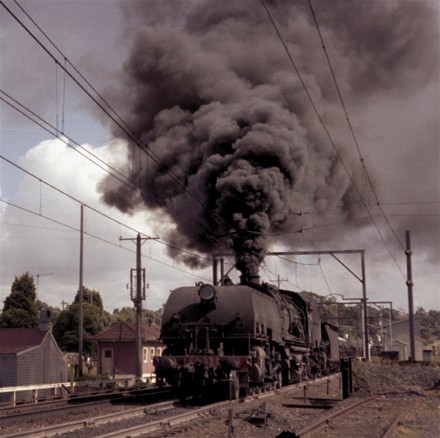4-8-4+4-8-4 on:
[Wikipedia]
[Google]
[Amazon]
Under the
 The second Double Northern locomotive class were the AD60 class Garratts of the Australian
The second Double Northern locomotive class were the AD60 class Garratts of the Australian
Whyte notation
Whyte notation is a classification method for steam locomotives, and some internal combustion locomotives and electric locomotives, by wheel arrangement. It was devised by Frederick Methvan Whyte, and came into use in the early twentieth cen ...
for the classification of steam locomotives by wheel arrangement
In rail transport, a wheel arrangement or wheel configuration is a system of classifying the way in which wheels are distributed under a locomotive. Several notations exist to describe the wheel assemblies of a locomotive by type, position, and c ...
, the is a Garratt articulated locomotive
An articulated locomotive is a steam locomotive (rarely, an electric locomotive) with one or more engine units that can move independent of the main frame. Articulation allows the operation of locomotives that would otherwise be too large to neg ...
. The wheel arrangement is effectively two 4-8-4
Under the Whyte notation for the classification of steam locomotives, represents the wheel arrangement of four leading wheels on two axles, eight powered and coupled driving wheels on four axles and four trailing wheels on two axles. The type wa ...
locomotives operating back to back, with the boiler
A boiler is a closed vessel in which fluid (generally water) is heated. The fluid does not necessarily boil. The heated or vaporized fluid exits the boiler for use in various processes or heating applications, including water heating, centr ...
and cab suspended between the two engine units. Each engine unit has two pairs of leading wheel
The leading wheel or leading axle or pilot wheel of a steam locomotive is an unpowered wheel or axle located in front of the driving wheels. The axle or axles of the leading wheels are normally located on a leading truck. Leading wheels are used ...
s in a leading bogie, followed by four coupled pairs of driving wheels and two pairs of trailing wheel
On a steam locomotive, a trailing wheel or trailing axle is generally an unpowered wheel or axle ( wheelset) located behind the driving wheels. The axle of the trailing wheels is usually located in a trailing truck. On some large locomotives, ...
s in a trailing bogie. Since the 4-8-4 type is sometimes known as a Northern, the corresponding Garratt type would be referred to as a Double Northern.
Overview
There were only two classes of 4-8-4+4-8-4 steam locomotives across the globe, all of which were constructed by Beyer, Peacock & Company, the owners of the Garratt patent. The predecessor 4-8-2+2-8-4 Double Mountain was probably the optimal Garratt wheel arrangement, with the four-wheeled leading bogies and the two-wheeled trailing trucks on each engine unit ensuring stability at speed and with sixteen coupled wheels for traction. More coupled wheels would inhibit the locomotive on tight curves, while the only advantage of more non-coupled wheels, such as on the Double Northern, was to reduce the axle loading.Use
Australia
 The second Double Northern locomotive class were the AD60 class Garratts of the Australian
The second Double Northern locomotive class were the AD60 class Garratts of the Australian New South Wales Government Railways
The New South Wales Government Railways (NSWGR) was the agency of the Government of New South Wales that administered rail transport in New South Wales, Australia, between 1855 and 1932.
Management
The agency was managed by a range of differen ...
, of which 47 were delivered in 1952. Of these, 42 were delivered fully assembled while the last five were delivered in pieces as spare parts. The locomotive weighed 260 imperial tons and was the largest locomotive in the Southern Hemisphere. The last of the AD60 class entered service in 1956 and the last one was withdrawn from service in 1973.
Four of the New South Wales AD60 class have been preserved.
* No. 6029 has been restored and was named ''City of Canberra'' until late 2017. It was restored to running condition in 2015.
* Numbers 6039 and 6042 are owned by the Dorrigo Steam Railway & Museum
The Dorrigo Steam Railway & Museum in Dorrigo, New South Wales, Australia is a large, privately owned collection of railway vehicles and equipment from the railways of New South Wales, covering both Government and private railways. The collecti ...
.
* No. 6040 is stored on display at NSW Rail Museum
The NSW Rail Museum is the main railway museum in New South Wales, Australia. A division of Transport Heritage NSW, it was previously known as the New South Wales Rail Transport Museum (NSWRTM), Rail Heritage Centre and Trainworks.
Transport H ...
, Thirlmere
Thirlmere is a reservoir in the Borough of Allerdale in Cumbria and the English Lake District. The Helvellyn ridge lies to the east of Thirlmere. To the west of Thirlmere are a number of fells; for instance, Armboth Fell and Raven Crag both ...
.
Kenya and Uganda
The first Double Northerns to be built were thirty class EC3 locomotives for the Kenya Uganda Railway (KUR). The thirty locomotives of the class were constructed in three batches in 1939, 1940 and 1949. These engines later became classes 57 and 58 on the East African Railways (EAR). One of the East African Railways locomotives survives, no. 87 ''Karamoja'' of 1940, EAR no. 5711. It is on display in the Nairobi Railway Museum in Kenya.References
External links
{{Whyte types 8,4-8-4 88,4-8-4+4-8-4